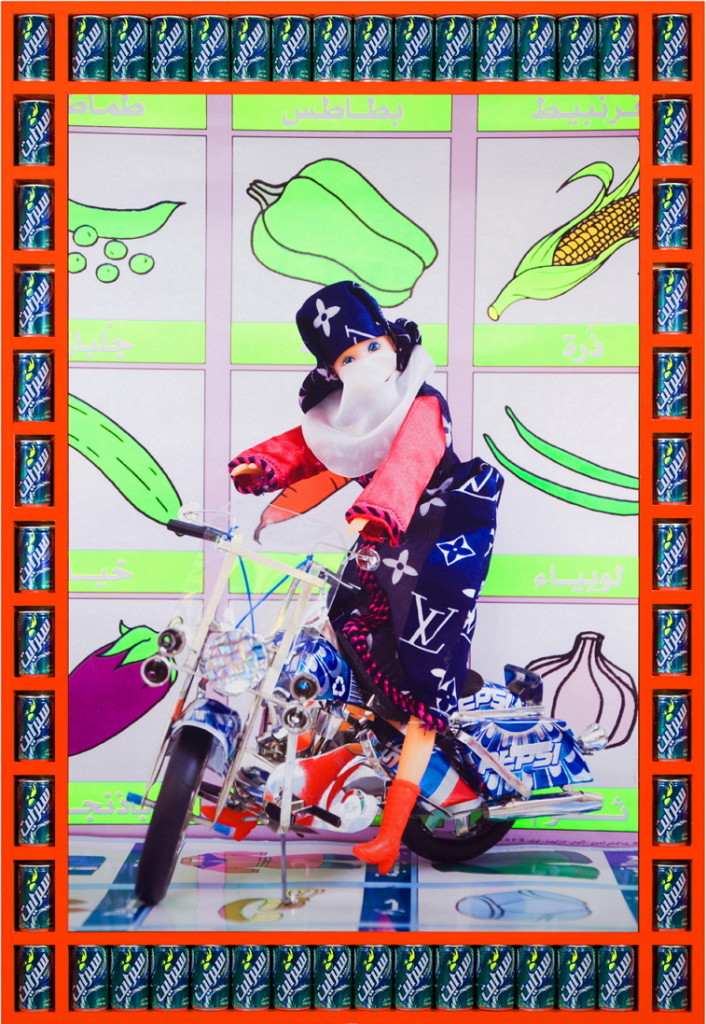
One of Hassan Hajjaj’s Moroccan Biker Barbie Dolls
Recently, London-based artist Hassan Hajjaj created a photo series in which he dressed Barbie dolls in Moroccan apparel embellished with designer brands. The juxtaposition of designer brands and traditional apparel is particularly striking, allowing the photos to pay homage to women’s biker culture while raising critical questions about the impact of Western consumer culture.
Hajjaj is not the only artist repurposing Barbie dolls. In fact, a large community of artists works with 1:6 scale models and figures, customizing them to more accurately represent objects of fandom. Sculpting, building, and customizing dolls can be an extremely lucrative industry. Those who purchase the dolls do so as a means of displaying their devotion to fandom and attention to detail. There is also a community of artists who work specifically with Barbie, and modify her in various ways. Loanne Hizo Ostile customizes Barbie, Kelly, and Ken dolls (as well as some Disney models) to be more racially diverse and inclusive. And designer Nickolay Lamm gained notoriety for creating a “normal Barbie” who had the proportions of an “average” 19-year-old woman.
These artists, like other 1:6 scale customizers, are creating products that reflect a vision they believe to be accurate, or one that they wish would be accurate. Where Mattel, Sideshow, and other mainstream brands fall short, there is a plethora of artists working toward inclusivity and more nuanced representations of bodies, cultures, and lifestyles. Barbie fandom and Barbie customization are certainly not mutually exclusive; in fact it seems that fandom, or at least wanting to legitimately better the product, can motivate people to customize the dolls.
However, there is also something to be said for detaching Barbie from her fan canon and viewing the doll as a piece of art. Enter AlteredBarbie, an annual art show in San Francisco that features Mattel icons repurposed in every possible way. For the creators of the show, “Barbie and Ken plastic icons represent modernity by having everything a person could desire today. They reflect corporate imposed lifestyles based on greed as well as the ore holistic concept of abundance.” Straddling the line between grotesque caricature and ideal beauty, Barbie and Ken become subjects rendered more complex by artists who “take Barbie boldly where Mattel/Disney would never have the guts to take her.” And the results are a mixed bag.
A list of “Barbie Gone Bad” compiles some of the most striking works from an earlier AlteredBarbie exhibit. Some, like Lavonne Sallee’s Rocky Horror Picture Show dolls, are indeed bold retellings and fusions of cultural icons. But other works in the show include insensitive, stereotyped depictions of eating disorders and drug and alcohol addiction. Even at its worst, the AlteredBarbie show forces us as viewers to consider the ramifications of incorporating Barbie into various scenarios. Dioramas that fuse Barbie with religion, BDSM, or blood and gore create an uncomfortable moment in which we must confront the idea of Western capitalist consumerism (vis-à-vis Barbie) infiltrating every other aspect of life.
Though perhaps less extreme in its execution, this is what Hajjaj’s photo series does as well. By remodeling Barbie, Hajjaj and other artists are radically reclaiming an artistic space dominated by wealthy, white entrepreneurs. By placing Barbie and her companions in situations that are physically violent, sexually explicit, or just plain unconventional, artists are questioning the intentional depiction of Barbie as a wholesome American girl. Stripped of her propriety and normative modes of accessorizing, Barbie becomes a means of powerful cultural critique and a language for cross-cultural artistic expression.
(Photo Credit: Over The Edge Books / Hassan Hajjaj)